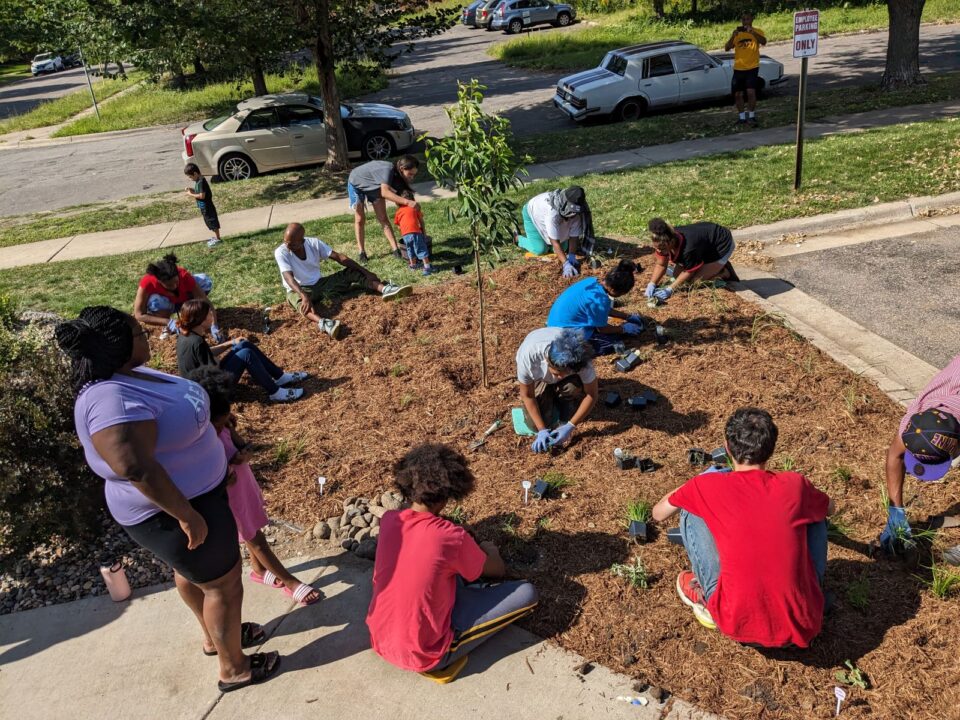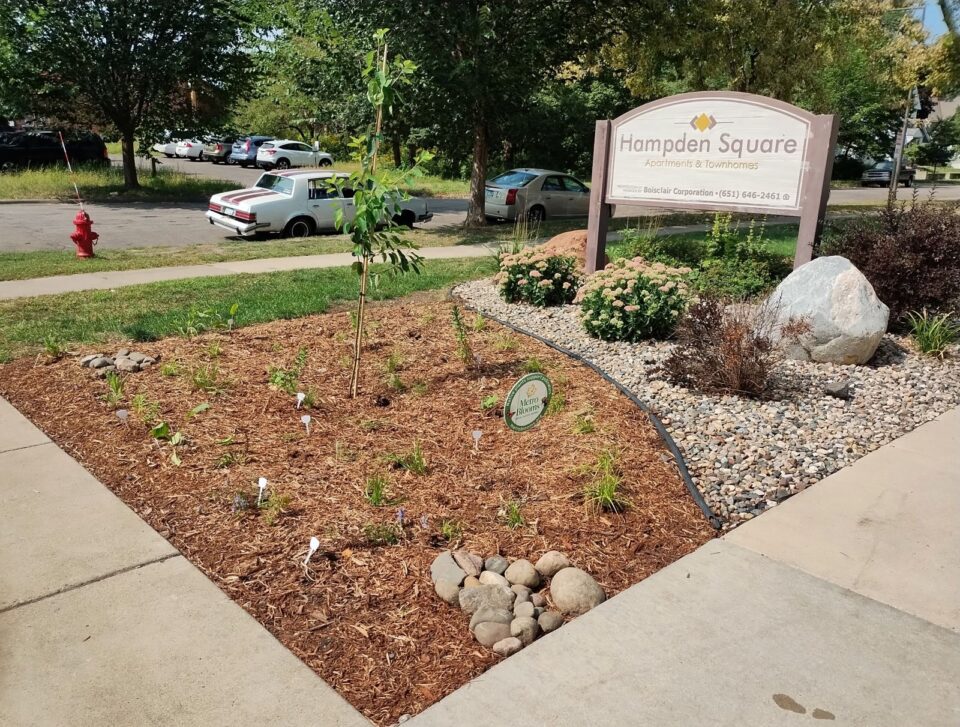Residents Build Rain Gardens to Protect the River
Polluted runoff – stormwater that flows over impervious surfaces and into storm sewers – is a leading cause of water pollution in lakes and rivers, particularly in urban areas. Much of the land in Capitol Region Watershed District (CRWD) is already developed and privately owned, so working with residents, non-profits, schools, businesses, and faith-based groups to build clean water projects is essential for improving water quality.
CRWD’s Clean Water Project Grants help build projects that prevent stormwater pollution and promote stewardship of our lakes and the Mississippi River. Projects like rain gardens, rainwater reuse systems, shoreline restorations, permeable pavement, and green roofs are all considered clean water projects because they help prevent stormwater pollution and keep our waters clean.
We’re featuring two recent rain garden projects funded by CRWD’s Clean Water Project Grant program. Rain gardens are bowl-shaped gardens designed to soak up and clean stormwater to help protect our lakes and the Mississippi River. Stormwater runoff soaks into the ground, where native plant roots and soil microbes help break down pollutants. The roots anchor the soil to prevent erosion and allow water to seep deeper into the ground. Native plants provide food and shelter for pollinators such as birds, bees, butterflies, and other wildlife.
Foley and Dolen Residential Rain Garden
Mike Foley and Jen Dolen wanted to make improvements to reduce runoff and erosion in the front yard of their home in Saint Paul’s Lexington-Hamline neighborhood. After learning about grants at a CRWD event, they applied for a Clean Water Project Grant in spring 2023. Mike explains the grant-to-garden process.
I staked out the space in the front yard, called Gopher State One Call to mark the buried utilities in the area, and completed a soil drainage test. Once the funding agreement with the watershed district was in place, I broke ground, bought the plants, and my wife Jen planted them. We added a fun footbridge for the postman to use as a shortcut. We also added some fun little elements, like a nice border to keep the mulch in its area.
Now, along with a pollinator garden we planted in the sideyard, it’s a little oasis for all sorts of bunnies, butterflies, birds, bees, and other critters. We love sitting on our porch during a heavy rainstorm and watching our rain garden fill and then quickly drain. We also love how the plants grow, bloom, and change through the seasons.
Completed in September 2023, Mike and Jen’s rain garden is 110 square feet and captures 9,500 gallons of runoff from their roof yearly. Before this project, water would go down their front yard to storm drains in the street that flow to the Mississippi River. Now, beautiful native plants soak up and clean the water while providing habitat for pollinators and wildlife. The plants in Jen and Mike’s rain garden include:
- Little bluestem
- Black-eyed Susan
- Prairie blazing star
- Blue flag iris
- Bebb’s sedge
- Great blue lobelia
Mike shared some notes on the garden’s progress and plans for more projects.
In the spring, we removed all the dead foliage from last year and wondered whether it would come back. A few days later, we saw little green shoots popping up, and before we knew it we had big, thriving plants again. The purple lilies bloomed in June, and the black-eyed Susans and blazing star plants are about to pop any day now. Plus, the grasses and sedges keep getting more and more full each week.
We couldn’t be more proud of our little creation, and we appreciate all the support we received from Ramsey County and Capitol Region Watershed District. Now, we’re hoping to save up money to replace our driveway with permeable pavers, and we might be able to get some more support from the watershed district for that project.
Hampden Square Homeowners Association Rain Gardens
Residents of the Hampden Square Apartments and Townhomes in Saint Paul’s Saint Anthony Park neighborhood installed four rain gardens to capture runoff from roofs, lawns, and sidewalks. The property management company, Boisclair Corporation, applied for a Clean Water Project Grant from CRWD to provide technical and financial support for the rain gardens. With the Clean Water Project Grant in place, Boisclair Corporation and Metro Blooms worked with residents to design and plant the gardens. A CRWD Partner Grant supported engagement with residents, including design sessions and planting efforts. Metro Blooms is a local non-profit dedicated to partnering with communities to create resilient landscapes and foster clean watersheds, embracing the values of equity and inclusion to solve environmental challenges.
Before the project, water would flow to the Mississippi River via storm drains. The native plants beautify the neighborhood while soaking up water and providing pollinator habitat to the community’s delight. The rain garden plants include:
- Black-eyed Susans
- Coneflower
- Dome aster
- Butterfly weed
- Plains oval sedge
- Prairie dropseed
- Side oats grama
- Blazing star
- Serviceberry
- Jacob’s ladder
- Blue false indigo
The four rain gardens are 75 to 150 feet in size, for a combined 430 square feet. Completed in October 2023, each garden captures and cleans approximately 7,000 gallons of water yearly.
Ongoing maintenance is critical to any clean water project. This project met the criteria for enrolling in a Clean Water Project Maintenance Grant to help support annual rain garden maintenance costs. For grant-funded clean water projects, maintenance activities and materials are eligible for reimbursement every year for the life of the project. After the installation in 2023, Boisclair Corporation and Metro Blooms have continued to engage residents in maintaining the rain gardens.
Considering a Rain Garden?
Rain gardens and other clean water projects can fit a variety of spaces, from a residential yard to a townhome association complex. Learn more about them on our Clean Water Projects Grant page.
CRWD has a variety of grant programs. Find out more about them in Your Guide to CRWD Grants.











